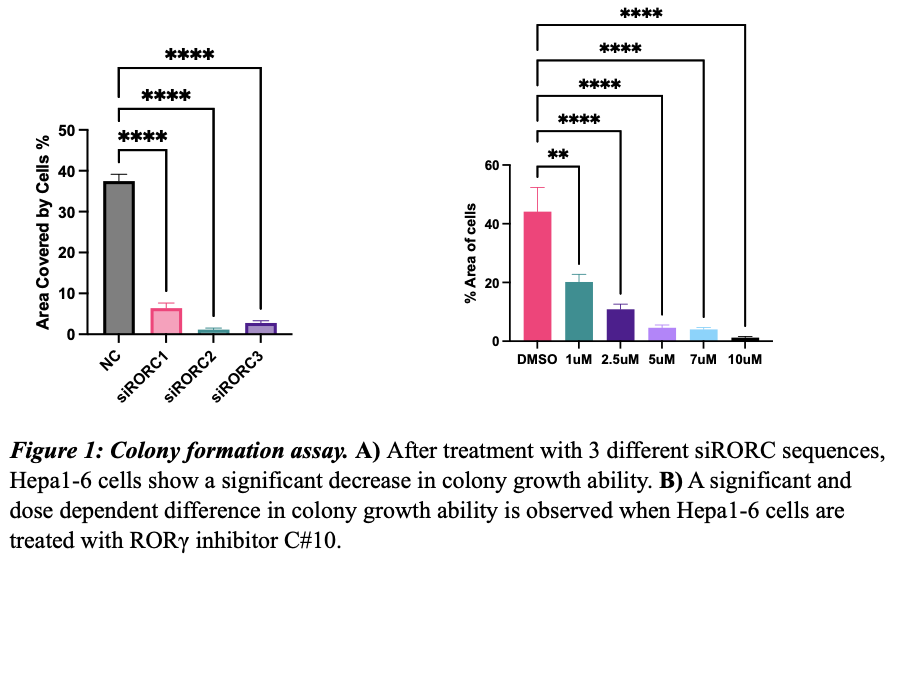The therapeutic potential of targeting nuclear receptor retinoic acid-related orphan receptor gamma in hepatocellular carcinoma
Sabrina Leo1,2, Sarita Negi2, Iqraa Dhoparee-Doomah1, Ahmed Fouda2, Steven Paraskevas2, Jonathan Cools-Lartigue1, Jean Tchervenkov2.
1Thoracic and Upper GI Research Laboratories, McGill University Health Center Research Institute, Montreal, QC, Canada; 2Transplantation Immunology Laboratory, McGill University Health Center Research Institute, Montreal, QC, Canada
Background: Hepatocellular carcinoma (HCC) primarily arises though inflammation-associated etiologic factors that lead to liver cirrhosis. Type 3 immunity which is characterized by cells that produce the pro-inflammatory IL-17A cytokine, which is modulated by the master transcriptional factor retinoid acid-related orphan receptor gamma (RORy), plays a significant role in acute and chronic allograft rejection. Moreover, over-expression of the cytokine and its transcription factor are implicated in inflammatory pathways that lead to metabolic syndrome, cirrhosis and the development of several cancers, including cirrhosis-induced HCC. Currently, liver transplantation is the most effective therapy for HCC. Advanced disease, however, is a contradiction due to the risk of recurrence. We therefore investigated whether RORy is expressed in human and mouse HCC cell lines, and if targeting the receptor affects HCC cell viability, proliferation, and colony formation.
Methods: Human HCC cell line HuH-7 and mouse HCC cell lines Hepa1-6 and Hep-55.1c were used. RORy-targeting silencing RNA (siRORC) sequences were designed and a novel RORy inverse agonist (C#10) generated at the McGill University Health Center Research Institute were used to inhibit RORy activity. The assays used to test the effects of siRORC and C#10 inhibition in HCC cells include cell viability assays, colony formation assays, cell proliferation assays, RT-qPCR, immunofluorescence microscopy and western blot.
Results: HCC cell lines HuH-7, Hepa1-6, and Hep-55.1c highly express nuclear receptor RORy. siRORC and C#10 reduced RORy expression in all 3 cell lines. Cell viability was decreased significantly in a dose dependent manner upon a 72 hour treatment with siRORC and inverse agonist C#10.

Colony formation assays revealed a visible and statistically significant reduction in HCC cell growth with siRORC and increasing concentrations of C#10.

In addition, cell proliferation rate is reduced with siRORC and reverse agonist C#10 treatment.
Conclusion: Human and mouse HCC cells highly express RORy. Targeting RORy with siRORC or RORy inverse agonist C#10 suppressed cell viability, cell proliferation and colony formation of all three cell lines. This data suggests that RORy is a potential target for HCC and may have the dual benefit of preventing allograft rejection and HCC recurrence after liver transplantation.
Avrith Liver Transplant Endowment Fund. MUHC-Foundation. MGH-Foundation Start Up Funds.
[1] Hepatocellular carcinoma
[2] HCC
[3] Allograft rejection
[4] Liver transplantation
[5] RORgamma
[6] Retinoic Acid-Related Orphan Receptor Gamma
[7] Novel therapeutic target
[8] cancer
